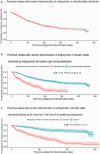Predictors of Lack of Relapse After Random Discontinuation of Oral and Long-acting Injectable Antipsychotics in Clinically Stabilized Patients with Schizophrenia: A Re-analysis of Individual Participant Data
- PMID: 34355232
- PMCID: PMC8886604
- DOI: 10.1093/schbul/sbab091
Predictors of Lack of Relapse After Random Discontinuation of Oral and Long-acting Injectable Antipsychotics in Clinically Stabilized Patients with Schizophrenia: A Re-analysis of Individual Participant Data
Abstract
Objective: To quantify the risk and predictors of relapse among individuals with schizophrenia randomly withdrawn from antipsychotic maintenance treatment.
Methods: We re-analyzed time-to-event and baseline predictors from placebo arms in five placebo-controlled randomized trials of antipsychotics (n = 688 individuals; 173 stabilized on oral antipsychotic [OAP] and 515 on long-acting injectables [LAI]) for relapse-prevention available in the Yale Open Data Access repository. Using a survival and Cox-proportional hazards regression analyses, we estimated survival rates of "relapse-free" individuals by the end of follow-up (median = 118 days, IQR = 52.0-208.0), the rate of study-confirmed relapse, and adjusted hazard ratios (aHR, 95% confidence intervals [CI]) associated with baseline predictors. We also estimated these parameters for individuals followed for >5 half-lives of the stabilizing antipsychotic, and studied predictors of "rebound psychosis" in OAP-stabilized participants, defined as occurring within 30 days of antipsychotic withdrawal.
Results: 29.9% (95%CI = 23.2-38.5) remained relapse-free by the end of follow-up, 11.1% (95%CI = 5.65-21.9) among those OAP-stabilized, 36.4% (95%CI = 28.4-46.7) among those LAI-stabilized. The study-confirmed relapse rate was 45.2%, 62.4% among those OAP-stabilized and 39.4% among those LAI-stabilized. Predictors of relapse included smoking (aHR = 1.54, 95%CI = 1.19-2.00), female sex (aHR = 1.37, 95%CI = 1.08-1.79), and having been stabilized on OAPs vs LAIs (aHR = 3.56, 95%CI = 2.68-4.72). Greater risk of relapse on OAP persisted even after sufficient time had elapsed to clear antipsychotic plasma level among LAI-stabilized (aHR = 5.0, 95%CI = 3.5-7.1). "Rebound psychosis" did not show predictors.
Conclusions and relevance: Our results corroborate the high relapse risk following antipsychotic withdrawal after symptom stabilization with limited patient-related predictors of safe treatment discontinuation. Stabilization with LAIs reduces the short-/medium-term relapse risk.
Keywords: antipsychotics; individual participant data; long-acting injectables; relapse; schizophrenia; withdrawal.
© The Author(s) 2021. Published by Oxford University Press on behalf of the Maryland Psychiatric Research Center. All rights reserved. For permissions, please email: journals.permissions@oup.com.
Figures

Comment in
-
Confounding of Antipsychotic Discontinuation Studies by Withdrawal-Related Relapse.Schizophr Bull. 2022 Mar 1;48(2):294-295. doi: 10.1093/schbul/sbab146. Schizophr Bull. 2022. PMID: 34964477 Free PMC article. No abstract available.
Similar articles
-
Time to Treatment Discontinuation in German Patients with Schizophrenia: Long-Acting Injectables versus Oral Antipsychotics.Clin Drug Investig. 2021 Jan;41(1):99-113. doi: 10.1007/s40261-020-00990-8. Epub 2020 Dec 17. Clin Drug Investig. 2021. PMID: 33331979 Free PMC article.
-
Adherence, health care utilization, and costs between long-acting injectable and oral antipsychotic medications in South Carolina Medicaid beneficiaries with schizophrenia.J Manag Care Spec Pharm. 2024 Jun;30(6):549-559. doi: 10.18553/jmcp.2024.30.6.549. J Manag Care Spec Pharm. 2024. PMID: 38824623 Free PMC article.
-
Long-acting injectable vs oral antipsychotics for relapse prevention in schizophrenia: a meta-analysis of randomized trials.Schizophr Bull. 2014 Jan;40(1):192-213. doi: 10.1093/schbul/sbs150. Epub 2012 Dec 17. Schizophr Bull. 2014. PMID: 23256986 Free PMC article.
-
Treatment discontinuation of long-acting injectables or oral atypical antipsychotics among Medicaid recipients with schizophrenia.J Med Econ. 2019 Nov;22(11):1105-1112. doi: 10.1080/13696998.2019.1615927. Epub 2019 May 23. J Med Econ. 2019. PMID: 31062998
-
Psychosis relapse during treatment with long-acting injectable antipsychotics in individuals with schizophrenia-spectrum disorders: an individual participant data meta-analysis.Lancet Psychiatry. 2020 Sep;7(9):749-761. doi: 10.1016/S2215-0366(20)30264-9. Lancet Psychiatry. 2020. PMID: 32828165
Cited by
-
Chronic Use of Antipsychotics in Schizophrenia: Are We Asking the Right Question?Schizophr Bull Open. 2022 Oct 18;3(1):sgac059. doi: 10.1093/schizbullopen/sgac059. eCollection 2022 Jan. Schizophr Bull Open. 2022. PMID: 36277256 Free PMC article. Review.
-
Long-Term Real-World Effectiveness of Aripiprazole Once-Monthly. Treatment Persistence and Its Correlates in the Italian and Spanish Clinical Practice: A Pooled Analysis.Front Psychiatry. 2022 Apr 28;13:877867. doi: 10.3389/fpsyt.2022.877867. eCollection 2022. Front Psychiatry. 2022. PMID: 35573364 Free PMC article.
-
The pharmacological treatment of schizophrenia: How far have we come?PCN Rep. 2022 May 30;1(2):e13. doi: 10.1002/pcn5.13. eCollection 2022 Jun. PCN Rep. 2022. PMID: 38868633 Free PMC article. Review.
-
Using in silico methods to determine optimal tapering regimens for decanoate-based long-acting injectable psychosis drugs.Ther Adv Psychopharmacol. 2024 Sep 12;14:20451253241272790. doi: 10.1177/20451253241272790. eCollection 2024. Ther Adv Psychopharmacol. 2024. PMID: 39282238 Free PMC article.
-
Use of Long-Acting Injectable Antipsychotics in Inpatients with Schizophrenia Spectrum Disorder in an Academic Psychiatric Hospital in Switzerland.J Pers Med. 2022 Mar 11;12(3):441. doi: 10.3390/jpm12030441. J Pers Med. 2022. PMID: 35330441 Free PMC article.
References
-
- Millan MJ, Andrieux A, Bartzokis G, et al. . Altering the course of schizophrenia: progress and perspectives. Nat Rev Drug Discov. 2016;15(7):485–515. - PubMed
-
- Almond S, Knapp M, Francois C, Toumi M, Brugha T. Relapse in schizophrenia: costs, clinical outcomes and quality of life. Br J Psychiatry. 2004;184:346–351. - PubMed
-
- Emsley R, Chiliza B, Asmal L. The evidence for illness progression after relapse in schizophrenia. Schizophr Res. 2013;148(1-3):117–121. - PubMed
-
- Mayoral-van Son J, de la Foz VO, Martinez-Garcia O, et al. . Clinical outcome after antipsychotic treatment discontinuation in functionally recovered first-episode nonaffective psychosis individuals: a 3-year naturalistic follow-up study. J Clin Psychiatry. 2016;77(4):492–500. - PubMed
Publication types
MeSH terms
Substances
LinkOut - more resources
Full Text Sources
Other Literature Sources
Medical

